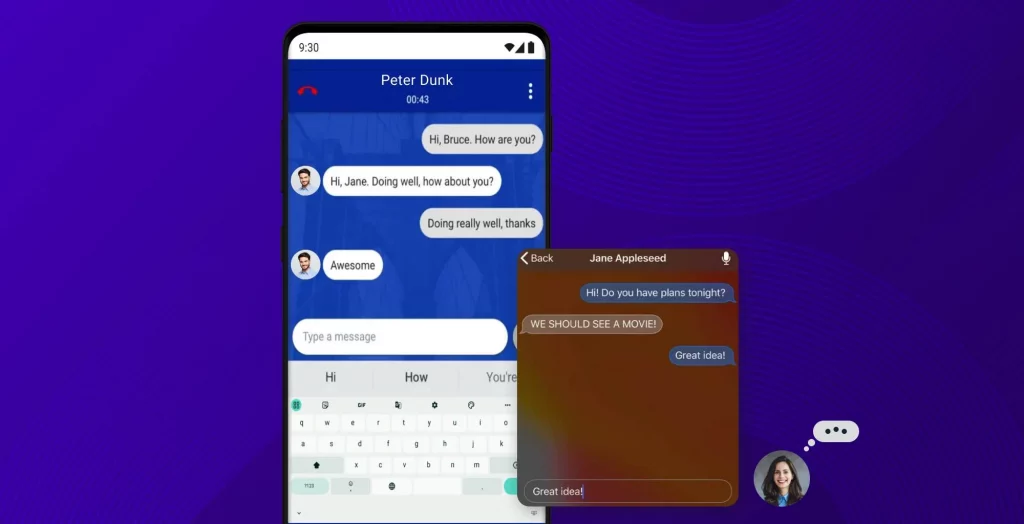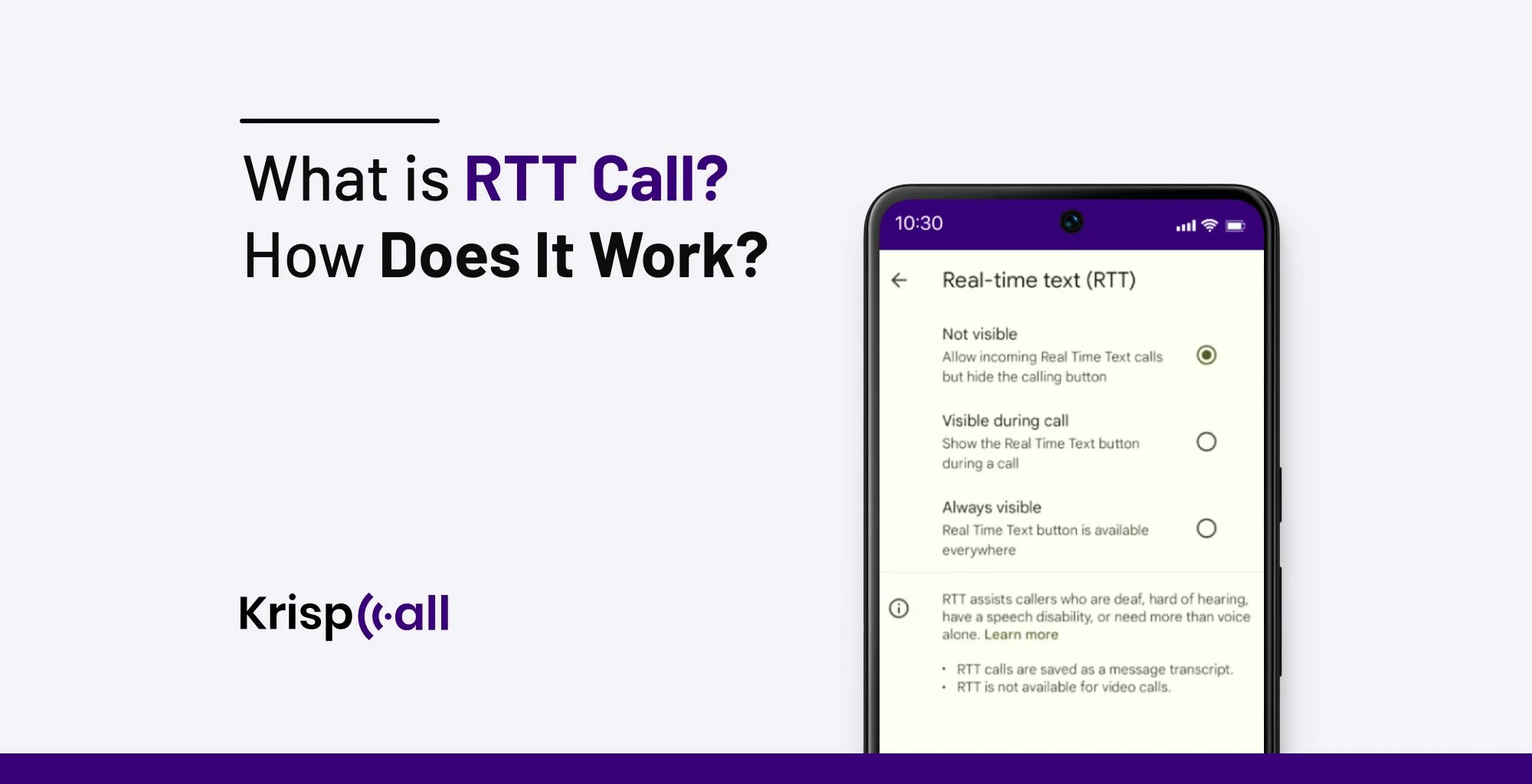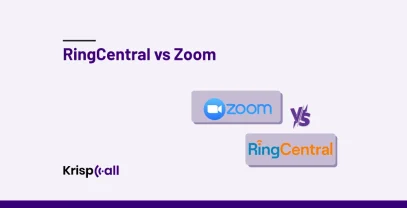How do you exchange information when you’re on the phone with someone?
By talking, I assume.
But what if the person on the other end is a deaf or hard-of-hearing phone user, among others? How would you exchange information, then?
The answer? – RTT Calls. Real-time text (RTT) calls enables deaf and hard-of-hearing phone users to better communicate during voice calls with real-time text.
Want to know how the ins and outs of what an RTT call is, alongside its benefits and challenges? Then, keep reading this blog.
🔑 KEY HIGHLIGHTS
- RTT (Real Time Text) Calls allow users to communicate entirely via SMS and send text messages as they type without hitting send, providing an accessible alternative to people with hearing or speech difficulties.
- In an RTT call, both parties see each other’s messages as they are typed, allowing a face-to-face chat exchange similar to a phone conversation phone.
- RTT offers benefits such as real-time error correction and access to emergency services, but there are also device compatibility limitations that need to be taken into account, as well as network issues.
- RTT’s real-time messaging experience can benefit all users in situations where speaking loudly is not possible or advisable, such as in noisy or quiet environments.
What Does RTT Call Mean?

RTT call is an advanced way of calling that lets users communicate not only with their voice but also through typing. This feature is especially beneficial for people who are deaf or have difficulty hearing.
When you’re sending a message using real-time text (RTT), the person on the other end can see what you’re typing as you type it, and they can reply right away. You don’t have to wait to hit “Send” like you do with regular text messages.
If you have a hard time understanding the voice messages during a call, you can switch to RTT and simply start texting, making it clear to understand anything that may not have been understood before.
Who Uses Real-Time Text (RTT) Technology?
- People with hearing or speech disabilities: RTT allows them to converse in real-time through text, providing an alternative to voice calls which they may not be able to use.
- Emergency services: RTT enables connections to emergency services like 911 without needing to speak. This makes emergency services more accessible to people with hearing or speech disabilities.
- Government agencies and businesses: Through relay services, people with hearing or speech issues can use RTT to connect to government agencies and businesses by typing instead of speaking.
- Potentially any users in situations where speaking is not possible or preferable: While aimed at accessibility, RTT’s real-time texting experience could benefit all users in contexts where speaking aloud may not be feasible or safe.
How RTT Calls Work?

RTT calls work by sending text messages as a user type without hitting the send button. They are a new way to have text chats at voice-like speeds. Messages can be read as they are typed. You do not need to wait for your turn to type, and people can interrupt you to clarify things. When two people enter a message at the same time, their texts will immediately appear on both phones as they type.
The closest way to simulate this real-world experience is to collaborate in real-time using Google Docs. Although the technical approaches differ, the end user experience is like seeing changes/additions appear instantly as other people type into the shared document. Just as changes are reflected dynamically in Google Docs, message text is constantly updated back and forth in live chat.
Similarly, RTT calls can be initiated and received with the same ten-digit numbers used for voice calls. However, standard rates may apply depending on your provider.
How is RTT Different From Instant Messaging?
RTT calling is different from instant messaging as it allows text to be sent and received in real-time without delay or interruption.
With other messaging apps, you don’t get to see what they are typing in real-time; the text may only show “User is typing”. However, in RTT, texts appear on the screen as they are being typed.
This makes it more suitable for having a natural and fluid conversation over the phone.
Benefits of RTT Calls
- This service allows people with hearing or speech impairments to chat in real-time via SMS, providing an alternative to voice calls.
- Text displays as you type, so both parties see errors and correct them in real-time, making it more like a live conversation. Unlike messaging applications where responses can arrive anytime, RTT ensures real-time interactive dialogue like a phone call.
- It provides higher reliability than the old TTY technology, which requires external devices. RTT uses a smartphone interface.
- Users have access to more characters to express themselves compared to TTY.
- RTT allows connection to emergency services, government agencies, and businesses through the relay operator without speaking, improving accessibility.
- RTT’s real-time messaging experience benefits all users in some situations where speaking may not be possible or preferred.
Challenges and Limitations of RTT
Even though RTT has some great features and has proven to be beneficial for people, there are still some challenges and limitations that come with it.
Some of the critical limitations are device compatibility and network connectivity. RTT likely cannot be utilized between phones on older 3G or earlier cellular networks. It also cannot connect with TTY landline devices that rely on separate teletypewriter technology instead of smartphones.
Even 911 emergency calls made using RTT may face issues if the dispatcher’s equipment only supports TTY rather than RTT. This could potentially cause certain typed messages to be misinterpreted or not come through clearly on either the user’s or dispatcher’s device.
RTT’s reach remains confined by the capabilities of participating networks and connected hardware. Universal adoption and consistent functionality across all devices and systems have yet to be achieved, which inhibits its usefulness in some communication scenarios. Continued modernization is still needed to fully resolve compatibility barriers.
Future of RTT: What to Expect?
While RTT is a significant improvement in accessibility, it still has limitations and room for growth. The FCC has urged cellular providers to continue developing additional features to make RTT even more inclusive.
Enhancements could allow for customization of text colors, sizes, and fonts to help those with visual impairments or conditions like dyslexia and colorblindness.
Currently, RTT lacks integration of caller ID, conferencing options, interactive voice systems, and call transfers needed to navigate automated phone systems. This presents difficulties for users needing to contact services.
Many expect technology companies to start offering RTT out of the box on devices by default in the future. This could ideally bring the benefits of real-time text conversations to those with disabilities from the moment they begin using a new device.
As development progresses, RTT aims to achieve full accessibility through ongoing innovation.
Final Thoughts
RTT calling provides a new way for people to connect even when talking isn’t possible. Whether you have trouble hearing or just don’t feel like talking, RTT lets you call friends by texting in real-time.
As more phones support this feature, it will help many users with disabilities easily communicate.
But RTT calling could also be useful for situations we all face, like taking a call in a quiet place. So, if talking on the phone isn’t an option, try placing an RTT call for a live text conversation instead!
FAQ
Does RTT mean someone is listening?
Using RTT does not mean someone else is listening. It allows for real-time text exchanges as an alternative to voice calls between two consenting users. The conversation remains between those two users who are involved in the RTT texts.
Why would someone call from RTT?
RTT is made for people with hearing or speech difficulties. Real-time text (RTT) allows them to participate in chat exchanges through typed text during a phone call.
Does RTT affect phone calls?
While RTT (Real-Time Text) provides an alternative text-based calling method, it can impact traditional voice calls in some ways since both utilize the same underlying phone networks and lines.
Can RTT calls be traced?
Cellular providers do not actively monitor or record the contents of unencrypted RTT conversations as they may do with some voice calls. Hence, users have a reasonable expectation of privacy for RTT, similar to standard text messaging.





